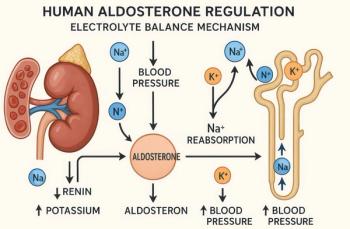
Unilateral Superficial Venous Thrombosis
Up to 40% of patients who present with what may look like simple, isolated superficial venous thrombosis have concomitant deep venous thrombosis. This finding has led clinicians to first rule out DVT bilaterally via compression Doppler ultrasonography before treatment is considered.
A 45-year-old man presented with pain in his left lower leg. Erythema and induration extended from the medial aspect of the lower extremity to a few centimeters proximal to the patella (A). The area was tender on palpation. Varicose veins were apparent on both legs. Venous Doppler ultrasonography (DUS) revealed a 4-cm thrombus with an anterior-posterior diameter of 4 mm and restriction of flow from the mid to distal great saphenous vein (B). Compressibility of the deep venous system of the legs was maintained without evidence of deep venous thrombosis (DVT).
Superficial venous thrombosis (SVT) has been treated conservatively and is thought to be typically benign.1-5 However, up to 40% of patients who present with what may look like simple, isolated SVT have concomitant DVT.1-3,6 In fact, one study noted concurrent DVT in 65% of patients with lower saphenous venous thrombosis.7 SVT spreads to the deep venous system in 7.3% to 44% of patients; the incidence is higher in those with thrombophilic disorders.8 This finding has led clinicians to first rule out DVT bilaterally via compression DUS before treatment is considered.1,3,9
Patients with SVT should be monitored by DUS for 48 hours after presentation to detect extension into the deep venous system.3 Further visualization may be indicated in certain patients, such as those with increased pain or an enlarging area of erythema and induration.
The prognosis and progression of SVT are determined on the basis of the specific veins and regions of the veins that are involved. Thrombosis of the greater saphenous vein, especially in proximity of the saphenofemoral junction, is associated with a higher rate of progression to DVT of the common femoral vein with the potential to evolve into a pulmonary embolus or other thromboembolic event.1-3,10 SVTs that are within 1 cm of the saphenofemoral junction are thought to be at greatest risk for extension and are treated with anticoagulation or ligation of the junction, with or without stripping of the greater saphenous vein.2,3 Thrombosis of the lesser saphenous vein also may progress to the popliteal vein of the deep venous system.2,3,5 Extension can also occur through perforating veins from the superficial to the deep systems.2,3
About 15% to 20% of patients with SVT have a recurrence.2 Patients with SVT associated with varicose veins are at higher risk for recurrence. Treatment of varicose veins after management of the acute process can decrease the likelihood of recurrence.1 Because blood stasis is an independent risk factor for SVT, patients should be educated on how to avoid venous pooling. This may include compression stockings during long car rides or flights as well as avoidance of prolonged standing.1,3 Daily elevation and increased ambulation can also be beneficial.
Although most SVT cases do not progress to DVT, aggressive follow-up care both clinically and radiologically is necessary to ensure resolution. This patient was treated with ibuprofen and application of warm compresses. Follow-up DUS performed 2 days after initial diagnosis showed evidence of clot stability. The patient was asymptomatic within 5 days. Follow-up DUS at 4 weeks revealed complete resolution of the SVT.
References:
REFERENCES:
1. Cesarone MR, Belcaro G, Agus G, et al. Management of superficial vein thrombosis and thrombophlebitis: status and expert opinion document. [published correction appears in Angiology. 2008;59:519]. Angiology. 2007;58(suppl 1):7S-15S.
2. Gorty S, Patton-Adkins J, DaLanno M, et al. Superficial venous thrombosis of the lower extremities: analysis of risk factors, and recurrence and role of anticoagulation. Vasc Med. 2004;9:1-6.
3. Gloviczki P, Yao JS, eds. Handbook of Venous Disorders: Guidelines of the American Venous Forum. 2nd ed. London: Arnold; 2001:179-183.
4. van Weert H, Dolan G, Wichers I, et al. Spontaneous superficial venous thrombophlebitis: does it increase risk for thromboembolism? A historic follow-up study in primary care. J Fam Pract. 2006;55:52-57.
5. Kalodiki E, Nicolaides AN. Superficial thrombophlebitis and low-molecular-weight heparins. Angiology. 2002;53:659-663.
6. Decousus H, Leizorovicz A. Superficial thrombophlebitis of the legs: still a lot to learn. J Thromb Haemost. 2005;3:1149-1151.
7. Ascher E, Hanson JN, Salles-Cunha S, Hingorani A. Lesser saphenous vein thrombophlebitis: its natural history and implications for management. Vasc Endovascular Surg. 2003;37:421-427.
8. Milio G, Siragusa S, Minà C, et al. Superficial venous thrombosis: prevalence of common genetic risk factors and their role on spreading to deep veins. Thromb Res. 2008;123:194-199.
9. RodrÃguez-Peralto JL, Carrillo R, Rosales B, RodrÃguez-Gil Y. Superficial thrombophlebitis. Semin Cutan Med Surg. 2007;26:71-76.
10. Bhopale S, Gundling K. Superficial thrombophlebitis and DVT: when to suspect the latter when you see the former. Consultant. 1996;36:140-143.
Newsletter
Enhance your clinical practice with the Patient Care newsletter, offering the latest evidence-based guidelines, diagnostic insights, and treatment strategies for primary care physicians.



















































































































































































































































































